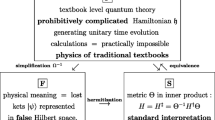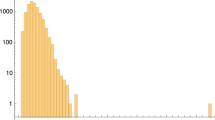Abstract
Essential to the description of a quantum system are its local degrees of freedom, which enable the interpretation of subsystems and dynamics in the Hilbert space. While a choice of local tensor factorization of the Hilbert space is often implicit in the writing of a Hamiltonian or Lagrangian, the identification of local tensor factors is not intrinsic to the Hilbert space itself. Instead, the only basis-invariant data of a Hamiltonian is its spectrum, which does not manifestly determine the local structure. This ambiguity is highlighted by the existence of dualities, in which the same energy spectrum may describe two systems with very different local degrees of freedom. We argue that in fact, the energy spectrum alone almost always encodes a unique description of local degrees of freedom when such a description exists, allowing one to explicitly identify local subsystems and how they interact. As a consequence, we can almost always write a Hamiltonian in its local presentation given only its spectrum. In special cases, multiple dual local descriptions can be extracted from a given spectrum, but generically the local description is unique.
Similar content being viewed by others
References
Schlosshauer M.: Decoherence, the measurement problem, and interpretations of quantum mechanics. Rev. Mod. Phys. 76(4), 1267 (2005)
Piazza F.: Glimmers of a pre-geometric perspective. Found. Phys. 40(3), 239–266 (2010)
Tegmark M.: Consciousness as a state of matter. Chaos Solitons Fractals 76, 238–270 (2015)
Wallace D.: The Emergent Multiverse: Quantum Theory According to the Everett Interpretation. Oxford University Press, Oxford (2012)
Zanardi P., Lidar D.A., Lloyd S.: Quantum tensor product structures are observable induced. Phys. Rev. Lett. 92(6), 060402 (2004)
Giddings S.B.: Hilbert space structure in quantum gravity: an algebraic perspective. J. High Energy Phys. 2015(12), 99 (2015)
Donnelly W., Giddings S.B.: Diffeomorphism-invariant observables and their nonlocal algebra. Phys. Rev. D 93(2), 024030 (2016)
Mumford, D., Fogarty, J., Kirwan, F.: Geometric invariant theory, 3rd edition, Springer (1994)
Hartshorne, R.: Algebraic Geometry. Springer, Berlin (2013)
Chen X., Chu M.T.: On the least squares solution of inverse eigenvalue problems. SIAM J. Numer. Anal. 33(6), 2417–2430 (1996)
Haag R.: Local Quantum Physics: Fields, Particles, Algebras. Springer, Berlin (2012)
Bravyi, S., Kitaev, A.: Fermionic quantum computation. arXiv preprint arXiv:quant-ph/0003137 (2000)
Riedel C.J., Zurek W.H., Zwolak M.: Objective past of a quantum universe: redundant records of consistent histories. Phys. Rev. A 93(3), 032126 (2016)
Riedel, C.J.: Classical branch structure from spatial redundancy in a many-body wavefunction (2016). arXiv:1608.05377
Zurek W.H.: Decoherence, einselection, and the quantum origins of the classical. Rev. Mod. Phys. 75(3), 715 (2003)
Schlosshauer M.: Decoherence, the measurement problem, and interpretations of quantum mechanics. Rev. Mod. Phys. 76(4), 1267 (2005)
Qi, X.-L.: Exact holographic mapping and emergent space–time geometry. arXiv:1309.6282 (2013)
Cao, C., Carroll, S.M., Michalakis, S.: Space from Hilbert space: recovering geometry from bulk entanglement. arXiv:1606.08444 (2016)
Cubitt, T., Montanaro, A., Piddock, S.: Universal quantum Hamiltonians. arXiv:1701.05182 (2017)
Aaronson, S: The complexity of quantum states and transformations: from quantum money to black holes. arXiv:1607.05256 (2016)
Brown, A.R., Susskind, L., Zhao, Y.: Quantum complexity and negative curvature. arXiv:1608.02612 (2016)
Brown, A.R., Susskind, L.: The second law of quantum complexity. arXiv:1701.01107 (2017)
Maldacena, J.: The large N limit of superconformal field theories and supergravity. In: Gamboa Saravi R.E., Falomir H., Schaposnik F.A. (eds.) AIP Conference Proceedings CONF-981170, vol. 484, no. 1. AIP (1999)
Witten, E.: Anti de Sitter space and holography. arXiv preprint arXiv:hep-th/9802150 (1998)
Almheiri, A., Dong, X., Harlow, D.: Bulk locality and quantum error correction in AdS/CFT. arXiv:1411.7041 (2014)
Pastawski, F., et al.: Holographic quantum error-correcting codes: Toy models for the bulk/boundary correspondence. arXiv:1503.06237 (2015)
Kitaev, A.: “A simple model of quantum holography.” http://online.kitp.ucsb.edu/online/entangled15/kitaev/, http://online.kitp.ucsb.edu/online/entangled15/kitaev2/ Talks at KITP, 7 April 2015 and 27 May 2015
Maldacena J., Stanford D.: Remarks on the Sachdev–Ye–Kitaev model. Phys. Rev. D 94(10), 106002 (2016)
Maldacena J., Stanford D., Yang Z.: Conformal symmetry and its breaking in two-dimensional nearly anti-de Sitter space. Prog. Theor. Exp. Phys. 2016(12), 12C104 (2016)
Cotler, J.S., et al.: Black holes and random matrices. arXiv:1611.04650 (2016)
García-García, A.M., Jacobus, J.M.V.: Analytical spectral density of the Sachdev–Ye–Kitaev model at finite N. arXiv:1701.06593 (2017)
Acknowledgements
We would like to thank Daniel Bump, Dylan Butson, Emilio Cobanera, Benjamin Lim, Edward Mazenc, Xiao-Liang Qi, Semon Rezchikov, Leonard Susskind, Arnav Tripathy, Ravi Vakil, and Michael Walter for their valuable discussions and support. We are also especially grateful to Patrick Hayden and Frances Kirwan for their valuable insights and feedback, and for reviewing this manuscript. JC is supported by the Fannie and John Hertz Foundation and the Stanford Graduate Fellowship program. DR is supported by the Stanford Graduate Fellowship program.
Author information
Authors and Affiliations
Corresponding author
Additional information
Communicated by M. M. Wolf
Publisher’s Note
Springer Nature remains neutral with regard to jurisdictional claims in published maps and institutional affiliations.
Rights and permissions
About this article
Cite this article
Cotler, J.S., Penington, G.R. & Ranard, D.H. Locality from the Spectrum. Commun. Math. Phys. 368, 1267–1296 (2019). https://doi.org/10.1007/s00220-019-03376-w
Received:
Accepted:
Published:
Issue Date:
DOI: https://doi.org/10.1007/s00220-019-03376-w




